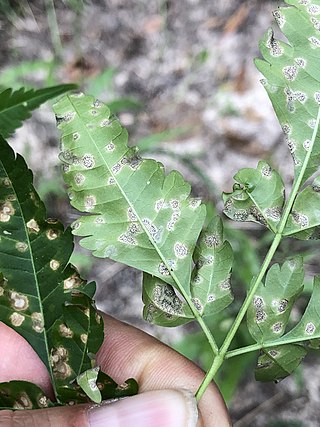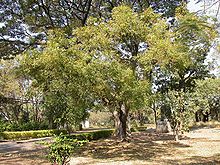
Quassia is a plant genus in the family Simaroubaceae. Its size is disputed; some botanists treat it as consisting of only one species, Quassia amara from tropical South America, while others treat it in a wide circumscription as a pantropical genus containing up to 40 species of trees and shrubs.

Azadirachta indica, commonly known as neem, margosa, nimtree or Indian lilac, is a tree in the mahogany family Meliaceae. It is one of two species in the genus Azadirachta. It is native to the Indian subcontinent and to parts of Southeast Asia, but is naturalized and grown around the world in tropical and subtropical areas. Its fruits and seeds are the source of neem oil. Nim is a Hindustani noun derived from Sanskrit nimba (निंब).

Meliaceae, the mahogany family, is a flowering plant family of mostly trees and shrubs in the order Sapindales.
Melia or Melie may refer to:

The curry tree or Bergera koenigii, is a tropical and sub-tropical tree in the family Rutaceae, native to Asia. The plant is also sometimes called sweet neem, though M. koenigii is in a different family to neem, Azadirachta indica, which is in the related family Meliaceae.

Neem oil, also known as margosa oil, is a vegetable oil pressed from the fruits and seeds of the neem, a tree which is indigenous to the Indian subcontinent and has been introduced to many other areas in the tropics. It is the most important of the commercially available products of neem, and its chemical properties have found widespread use as a pesticide in organic farming.

Melia azedarach, commonly known as the chinaberry tree, pride of India, bead-tree, Cape lilac, syringa berrytree, Persian lilac, Indian lilac, or white cedar, is a species of deciduous tree in the mahogany family, Meliaceae, that is native to Indomalaya and Australasia.

The Burseraceae are a moderate-sized family of 17-19 genera and about 540 species of woody flowering plants. The actual numbers given in taxonomic sources differ according to taxonomic revision at the time of writing. The Burseraceae are also known as the torchwood family, the frankincense and myrrh family, or simply the incense tree family. The family includes both trees and shrubs; its species are native to tropical regions of Africa, Asia, Australasia, and the Americas.
White cedar may refer to several different trees:

Synoum is a monotypic genus of evergreen tree in the family Meliaceae. It is endemic to Australia where it is found along the eastern sub-tropical to tropical coast, usually on the margins of rainforests, in Queensland and New South Wales.
Neem cake organic manure is the by-product obtained in the process of cold pressing of neem tree fruits and kernels, and the solvent extraction process for neem oil cake. It is a potential source of organic manure under the Bureau of Indian Standards, Specification No. 8558. Neem has demonstrated considerable potential as a fertilizer. For this purpose, neem cake and neem leaves are especially promising. Puri (1999), in his book on neem, has given details about neem seed cake as manure and nitrification inhibitor. The author has described that, after processing, neem cake can be used for partial replacement of poultry and cattle feed.

Pseudocercospora subsessilis is a fungal plant pathogen infecting chinaberry tree. It is widespread in tropical and subtropical areas on host species of the genera Azadirachta and Swietenia.

Melia is a genus of flowering trees in the family Meliaceae. The name is derived from μελία, the Greek name used by Theophrastus for Fraxinus ornus, which has similar leaves.

Tithonia is a genus of flowering plants in the tribe Heliantheae within the family Asteraceae.

Nimbin is a triterpenoid isolated from Neem. Nimbin is thought to be responsible for much of the biological activities of neem oil, and is reported to have anti-inflammatory, antipyretic, fungicidal, antihistamine and antiseptic properties.
Phomopsis azadirachtae is a fungus, a species of the genus Phomopsis. It has been identified as the fungus responsible for dieback in Azadirachta indica (neem) in India. The species was first identified and described by Sateesh et al in 1997.
Azadirachta excelsa, commonly known as sentang, is a tree in the mahogany family Meliaceae. The specific epithet excelsa is from the Latin meaning "lofty".
Penicillium citrinum is an anamorph, mesophilic fungus species of the genus of Penicillium which produces tanzawaic acid A-D, ACC, Mevastatin, Quinocitrinine A, Quinocitrinine B, and nephrotoxic citrinin. Penicillium citrinum is often found on moldy citrus fruits and occasionally it occurs in tropical spices and cereals. This Penicillium species also causes mortality for the mosquito Culex quinquefasciatus. Because of its mesophilic character, Penicillium citrinum occurs worldwide. The first statin (Mevastatin) was 1970 isolated from this species.

The sacred groves is a zone of Biodiversity Park, Visakhapatnam located in the premises of Rani Chandramani Devi Government Hospital. It has more than 100 sacred plant species, which are medicinal herbs with religious importance. Many sacred plants are becoming rare and endangered. Hence they are to be reared, protected, and conserved. The zone was inaugurated on February 5, 2017, by Kambhampati Hari Babu, a member of parliament from Visakhapatnam, Andhra Pradesh.

Gedunin is a pentacyclic triterpenoid with the molecular formula C28H34 O7. It is most notably found in Azadirachta indica, but is a constituent of several other plants. Gedunin shows therapeutic potential in the treatment of leukemia, and Parkinson's disease.













